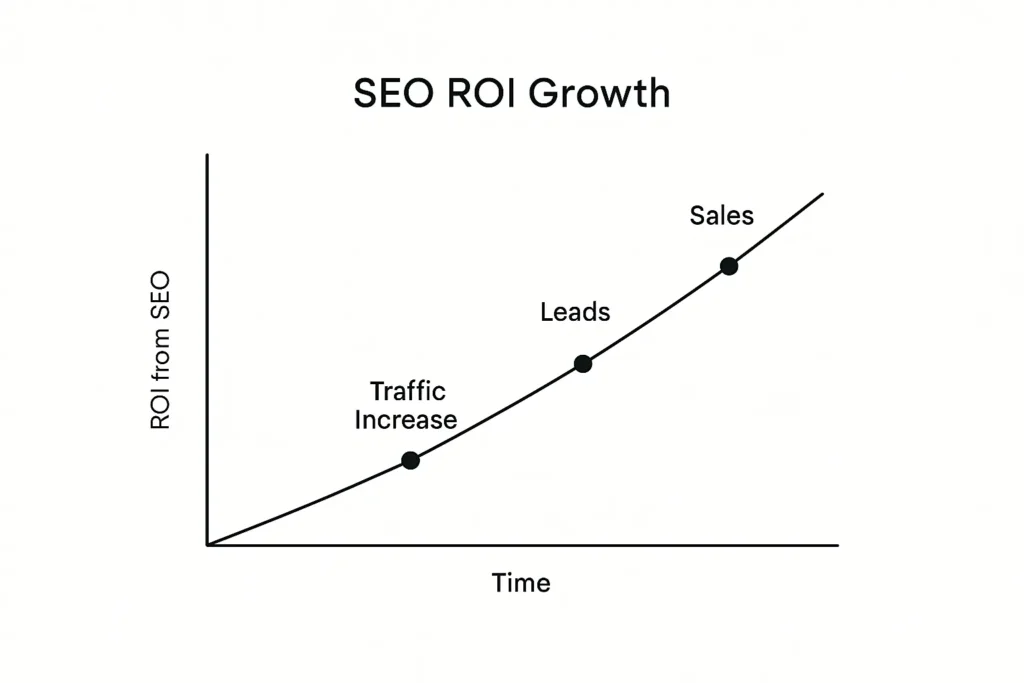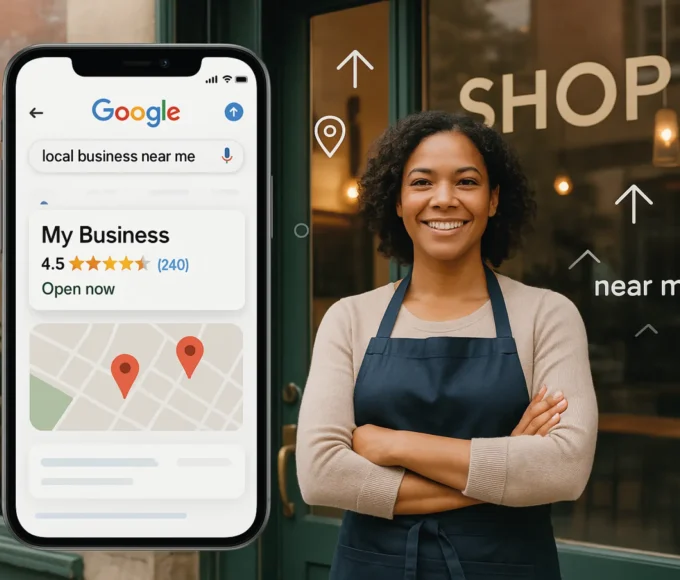A Practical 2025 Guide for Business Owners (with a Real-World Success Story)
“If I invest in SEO, will it actually make me money?”
This is the big question almost every business owner and startup founder asks.
And you’re right to ask it.
No serious entrepreneur wants to blindly invest money and “hope for the best.” You want clarity. You want proof. You want a path.
You want to know →
- What exactly SEO can do for your business
- Whether it generates real ROI (return on investment)
- How to track that ROI with precision (not guesswork)
Here’s exactly what I’m going to walk you through today — clearly and practically:
- Why SEO is no longer optional in 2025 — and why it’s your best long-term growth lever
- How I personally measure SEO ROI step-by-step — in a way business owners can easily understand
- A real-world success story — how one ecommerce brand earned 622% ROI through smart SEO
- And before we finish → mistakes to avoid and powerful benefits of SEO that most people overlook
Ready? Let me show you how this all works — starting right now.
Why SEO Is a Smart Investment in 2025
Let’s be blunt — SEO is no longer optional.
In today’s digital economy, SEO has become a core driver of business growth.
Here’s why:
1. Paid Ads are Getting More Expensive — and Less Sustainable
Platforms like Google Ads, Facebook, and LinkedIn have seen CPC (Cost Per Click) rates skyrocket.
This squeezes margins, especially for small and medium-sized businesses.
And the moment you stop paying for ads → your traffic stops too.
No payments = No visitors.
In contrast → SEO keeps delivering free traffic, even if you pause your efforts for a while.
2. Competition is Fierce — Organic Visibility is Critical
More brands are online now than ever.
Consumers are searching. If your brand doesn’t show up organically → you are invisible.
Organic rankings are prime real estate.
If you don’t claim it, your competitors will.
3. SEO is a Long-Term, Compounding Growth Channel
Once your site ranks → it becomes a marketing asset.
Every day, it brings in relevant, high-intent visitors → without ongoing ad spend.
And the best part → Older content continues to generate leads and sales year after year.
2025 Stat to Know
Brands have now shifted 43% of digital marketing budgets to SEO and content marketing, realizing that organic growth is more sustainable and profitable than paid ads.
In short → SEO makes your brand discoverable, trustworthy, and scalable.
What Does SEO ROI Mean (and Why Is It Sometimes Hard to Measure)?
Unlike paid ads (where you can see direct spend vs revenue easily), SEO delivers multi-dimensional value.
That’s why ROI from SEO has to be viewed more holistically.
Tangible ROI → Direct Business Outcomes
- Sales made from organic search visitors
- Leads generated from SEO-optimized landing pages
- Subscriptions, form submissions, phone calls from SEO traffic
Intangible ROI → Business Equity
- Trust → People trust organic results more than ads
- Brand Authority → Top ranking brands dominate mindshare
- Future-Proofing → Less dependency on volatile ad platforms and rising paid media costs
Pro tip →
Organic visitors generally show higher purchase intent than paid visitors.
They found you → they trust you → they’re more likely to buy.
So, SEO ROI is not just about short-term revenue.
It’s about building a long-term, powerful marketing engine.

How to Measure SEO ROI (Step-by-Step)
This is where most businesses stumble.
But don’t worry → Here’s how to approach it with clarity.
Step 1 → Define Clear SEO Goals
You can’t measure success without defining it first.
Set SMART SEO goals:
- Revenue goals → X number of sales, Y number of leads.
- Engagement goals → Organic traffic growth, ranking targets, form submissions.
Without clear targets, you’ll always be guessing.
Step 2 → Set Up Tracking the Right Way
Data matters → guesses don’t.
- Google Analytics 4 (GA4): Track organic sessions, conversions, and revenue.
- CRM Integration: Link conversions/leads to organic sessions.
- Attribution Models: SEO often influences assisted conversions → use first-click and linear attribution models too (not just last-click).
Note → SEO visitors often come back multiple times → don’t underestimate their journey.
Step 3 → Calculate Your SEO Investment (Total Cost)
ROI calculation is impossible without knowing your cost.
Include everything →
- SEO agency/consultant fees
- Salaries of in-house SEO staff
- Content creation (writers, designers)
- Tools → Ahrefs, Semrush, Screaming Frog
- Technical SEO and website maintenance
Bottom line → calculate true, all-inclusive SEO costs.
Step 4 → Calculate SEO ROI
Here’s the simple formula:
(SEO Revenue – SEO Cost) ÷ SEO Cost → ROI %
Example:
- SEO Spend → $20,000
- Revenue from Organic → $80,000
ROI = ($80K – $20K) ÷ $20K = 300% ROI
This means → for every $1 invested, you earned $3 back.
Not bad at all — and in SEO, this can scale up to 500%, 1000%, or even more in some industries.
Case Study → How Bleuet Achieved 7,200% Revenue Growth with SEO
Bleuet, a fast-growing direct-to-consumer (DTC) brand offering age-appropriate undergarments for young girls, faced a serious growth challenge.
Like many online brands, they were heavily dependent on paid ads to drive traffic and sales. However, this approach came with rising costs and diminishing returns. Their Customer Acquisition Cost (CAC) kept increasing, and their sales pipeline was dangerously tied to continuous ad spending.
The moment they reduced their ad budget, traffic would vanish — and so would sales.
They realized they needed a sustainable alternative. They needed to build organic visibility and free themselves from the endless paid ads treadmill.
That’s when they decided to invest seriously in SEO.
From Paid Reliance to Organic Growth Engine
Partnering with a specialist SEO agency, Bleuet focused on transforming their website and content into an organic lead and sales generator.
The strategy was straightforward but powerful:
→ They cleaned up technical issues on their website that were limiting search visibility.
→ They created valuable, targeted content around what their customers were actively searching for — addressing queries like “best training bras for tweens” and “bras for sensitive skin”.
→ They also built backlinks from trusted parenting communities and relevant online publications to improve domain authority and trust in Google’s eyes.
Each effort built on the other → and within months, Google began rewarding them.
The Transformation
Once the SEO strategy kicked in, Bleuet saw remarkable results:
- Their organic traffic skyrocketed by over 9,000%, opening the floodgates to new potential customers.
- Revenue followed suit, growing by an astounding 7,200% as more visitors found their website naturally, without paid ads.
- They significantly reduced their CAC, as organic traffic does not require continuous ad spend.
Most importantly → Bleuet transformed from a brand that had to “pay to play” into a business that attracted customers naturally, built brand trust, and generated sales organically — every single day.
Business Owner Takeaway
Bleuet’s success shows that SEO is not a gamble.
When done right, SEO becomes a long-term growth engine:
- It lowers acquisition costs.
- It brings qualified, high-intent visitors.
- It builds brand trust and authority.
- It ensures sales keep flowing, even when ad budgets are paused.
If your business is currently stuck in the paid ads cycle — SEO offers a smarter, more scalable path forward.
Like Bleuet, you can turn your website into your strongest sales channel → and achieve extraordinary growth without burning cash on ads forever.
How Long Does SEO Take to Deliver ROI?
SEO is not a get-rich-quick scheme.
But it is a long-term compounding channel.
| Timeline | Results |
| 3–6 Months | Early ranking, traffic growth |
| 6–12 Months | Traffic → leads + conversions → ROI begins |
| 12+ Months | SEO engine built → exponential, self-sustaining results |
If you need results this month → SEO won’t help.
If you need growth this year and beyond → SEO is your best bet.
Intangible Benefits of SEO ROI → The Hidden Power
Most businesses only focus on direct ROI.
Smart ones → understand SEO’s hidden advantages:
- Trust and Authority → Top organic rankings = perceived market leader
- Lower CAC → No need to pay per click → higher margins
- Sustainability → Great content keeps working 24/7 → lead generation never stops
- Market Leadership → SEO helps dominate niches and outlast competitors
Pitfalls to Avoid When Measuring SEO ROI
- Not attributing properly: SEO visitors often buy later → track assisted conversions too.
- Being impatient: SEO takes months → expect realistic timelines.
- Misalignment with business goals: Traffic alone means nothing → focus on leads, revenue, and brand lift.
SEO is not a vanity metric game → it’s about profitable business outcomes.
Final Takeaway → SEO = Business Growth Engine (Not Just a Marketing Tactic)
SEO is NOT an expense.
SEO is NOT a gamble.
SEO is an asset → that grows stronger, smarter, and more profitable every single month.
If you’re serious about building a brand and reducing dependency on volatile paid channels → SEO should become the centerpiece of your growth strategy.











Leave a comment